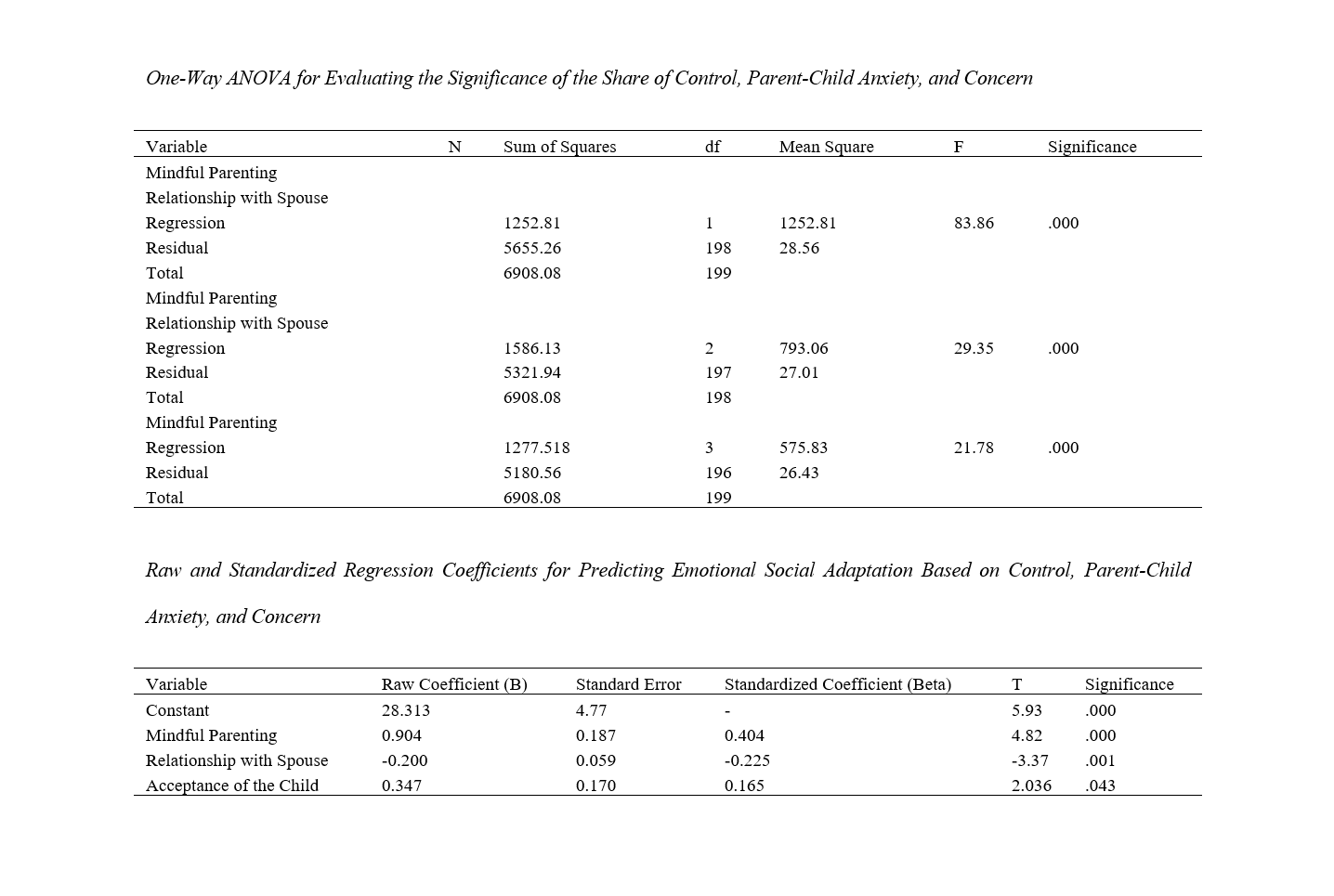Development of an Educational-Psychological Manual for Parenting After Divorce Based on Positive Parenting and Investigating the Effectiveness of the Developed Manual on Children's Emotion Regulation
Keywords:
Divorce, Children of Divorce, Emotion Regulation, Positive Parenting, Educational-Psychological ManualAbstract
This study aimed to develop an educational-psychological manual for parenting after divorce based on positive parenting and to investigate its effectiveness on emotion regulation. The research employed a mixed-method approach, incorporating qualitative phenomenology. The study population consisted of 16 custodial parents selected through purposive sampling from visitors to a family court complex in Tehran, employing semi-structured interviews. Data were analyzed using the seven-step process by Colaizzi. The quantitative section of the research was a quasi-experimental pre-test and post-test design. The statistical population was 177 parents, of whom 26 were selected through convenience sampling from parents who responded to the Shields and Cicchetti Emotion Regulation Questionnaire (1997) and whose children scored lower. These participants were randomly assigned to experimental and control groups and analyzed using multivariate analysis of covariance (MANCOVA). The qualitative research findings led to 7 main themes and 46 sub-themes. The quantitative findings showed that the developed educational-psychological manual has a significant effect on the emotion regulation of children of divorce (p < 0.001). Therefore, the educational-psychological manual based on positive parenting can be used for the emotional regulation problems of children after divorce.
Downloads
References
1. Ammari S, Deyreh E, Keykhosrovani M, Ganji K. The Effectiveness of Couple Therapy on Depressive Symptoms and Sexual Function in Women Affected by Infidelity. Razi Journal of Medical Sciences. 2023;29(7):54-63.
2. Ghorbani Amir HA, Moradi O, Arefi M, Ahmadian H. The Effectiveness of Cognitive behavior therapy and Acceptance and Commitment therapy (ACT) on Self-Control and Resiliency in Divorced Women. Journal of Applied Family Therapy. 2023;3(4):493-508. [DOI]
3. Rasouli Rad A, Rahmani MA, Shiroudi SG, Zarbakhsh MR. Comparing the Effectiveness of Schema Therapy and Mutual Behavior Analysis on Marital Heartbreak, Marital Conflict and Communication Skills of Couples Applying for Divorce. Islamic Life Style. 2023;6(4):788-99.
4. Parsakia K, Darbani SA. Effectiveness of strength-based counseling on self-worth of divorced women. Applied Family Therapy Journal (AFTJ). 2022;3(1):687-700. [DOI]
5. Bornstein MH. Cultural Approaches to Parenting. Parenting. 2012;12(2-3):212-21. [PMID: 22962544] [PMCID: PMC3433059] [DOI]
6. Schertz HH, Odom SL, Baggett KM, Sideris JH. Effects of Joint Attention Mediated Learning for toddlers with autism spectrum disorders: An initial randomized controlled study. Early Childhood Research Quarterly. 2013;28(2):249-58. [DOI]
7. Motataianu IR. The Relation between Anger and Emotional Synchronization in Children from Divorced Families. Procedia - Social and Behavioral Sciences. 2015;203:158-62. [DOI]
8. Panadero E. A Review of Self-regulated Learning: Six Models and Four Directions for Research. Frontiers in Psychology. 2017;8. [PMID: 28503157] [PMCID: PMC5408091] [DOI]
9. Besharat R, Soltani Azemat E, Mohammadian A. A Comparative Study of Rumination, Healthy Locus of Control, and Emotion Regulation in Children of Divorce and Normal Children. Practice in Clinical Psychology. 2018;6(4):207-14. [DOI]
10. Ding R, Wu N, Tang S, Liu T, Li W, Ni S. Relations between parental response to children's negative emotions and suicidal ideation in chinese adolescents: Internalizing problems, emotion regulation, and perceived relationship quality with parents as mediators. Journal of Affective Disorders. 2022;301:205-16. [PMID: 35033594] [DOI]
11. Morris AS, Silk JS, Steinberg L, Myers SS, Robinson LR. The Role of the Family Context in the Development of Emotion Regulation. Social Development. 2007;16(2):361-88. [PMID: 19756175] [PMCID: PMC2743505] [DOI]
12. Speidel R, Wang L, Cummings EM, Valentino K. Longitudinal pathways of family influence on child self-regulation: The roles of parenting, family expressiveness, and maternal sensitive guidance in the context of child maltreatment. American Psychological Association; 2020. p. 608-22. [PMID: 32077728] [PMCID: PMC7041838] [DOI]
13. Cavicchioli M, Tobia V, Ogliari A. Emotion Regulation Strategies as Risk Factors for Developmental Psychopathology: a Meta-analytic Review of Longitudinal Studies based on Cross-lagged Correlations and Panel Models. Research on Child and Adolescent Psychopathology. 2023;51(3):295-315. [PMID: 36208360] [DOI]
14. Seiffge-Krenke I. Parenting adolescents in an increasingly diverse world: links to adolescents’ psychopathology. Psychology. 2020;11(6):874-87. [DOI]
15. Sanders MR, Kirby JN, Tellegen CL, Day JJ. The Triple P-Positive Parenting Program: A systematic review and meta-analysis of a multi-level system of parenting support. Clinical Psychology Review. 2014;34(4):337-57. [PMID: 24842549] [DOI]
16. Sanders MR. The Triple P System of Evidence-Based Parenting Support: Past, Present, and Future Directions. Clinical Child and Family Psychology Review. 2023;26(4):880-903. [PMID: 37432507] [PMCID: PMC10640495] [DOI]
17. van Ijzendoorn MH, Schuengel C, Wang Q, Bakermans-Kranenburg MJ. Improving parenting, child attachment, and externalizing behaviors: Meta-analysis of the first 25 randomized controlled trials on the effects of Video-feedback Intervention to promote Positive Parenting and Sensitive Discipline. Development and Psychopathology. 2023;35(1):241-56. [PMID: 35034668] [DOI]
18. David OA, Capris D, Jarda A. Online Coaching of Emotion-Regulation Strategies for Parents: Efficacy of the Online Rational Positive Parenting Program and Attention Bias Modification Procedures. Frontiers in Psychology. 2017;8. [DOI]
19. Wisman MA, Emmelkamp J, Dekker JJM, Christ C. Internet-based emotion-regulation training added to CBT in adolescents with depressive and anxiety disorders: A pilot randomized controlled trial to examine feasibility, acceptability, and preliminary effectiveness. Internet Interventions. 2023;31:100596. [PMID: 36545446] [PMCID: PMC9760653] [DOI]
20. Mousavi amirabad z, nazarimoghadam p. Effectiveness of positive parenting skills training on social competence and emotion regulation in student. Rooyesh-e-Ravanshenasi Journal(RRJ). 2019;8(10):39-46.
21. Black CFD. Partner Emotional Support and Child Problem Behaviors: The Indirect Role of Harsh Parenting for Young Mothers and Their Children. Family Process. 2022;61(1):375-90. [PMID: 33908029] [PMCID: PMC8812210] [DOI]
22. DiMarzio K, Parent J, Forehand R, Thigpen JC, Acosta J, Dale C, Compas B. Parent-Child Role Confusion: Exploring the Role of Family Processes in the Context of Parental Depression. Journal of Clinical Child & Adolescent Psychology. 2022;51(6):982-96. [PMID: 33769163] [PMCID: PMC8464626] [DOI]
23. Cao H, Fine MA, Zhou N. The Divorce Process and Child Adaptation Trajectory Typology (DPCATT) Model: The Shaping Role of Predivorce and Postdivorce Interparental Conflict. Clinical Child and Family Psychology Review. 2022;25(3):500-28. [PMID: 35106699] [PMCID: PMC8805665] [DOI]
24. Collado A, Felton JW, Taylor H, Doran K, Yi R. The Indirect Effects of Trait Anxiety on Drug Use Via Emotion Dysregulation in a Low-Income Sample. Substance Use & Misuse. 2020;55(8):1320-6. [PMID: 32186420] [PMCID: PMC7255053] [DOI]
25. Nambiar PP, Jangam KV, Jose A, Seshadri SP. Predictors of behavioral and emotional issues in children involved in custody disputes: A cross sectional study in urban Bengaluru. Asian Journal of Psychiatry. 2022;67:102930. [PMID: 34861567] [DOI]
26. Zhao F, Wu H, Li Y, Zhang H, Hou J. The Association between Coparenting Behavior and Internalizing/Externalizing Problems of Children and Adolescents: A Meta-Analysis. International Journal of Environmental Research and Public Health. 2022;19(16):10346. [PMID: 36011980] [PMCID: PMC9407961] [DOI]
27. Zitzmann J, Rombold-George L, Rosenbach C, Renneberg B. Emotion Regulation, Parenting, and Psychopathology: A Systematic Review. Clinical Child and Family Psychology Review. 2024;27(1):1-22. [PMID: 37704867] [PMCID: PMC10920465] [DOI]
28. van Berkel SR, Prevoo MJL, Linting M, Pannebakker F, Alink LRA. What About the Children? Co-Occurrence of Child Maltreatment and Parental Separation. Child Maltreatment. 2024;29(1):53-65. [PMID: 36154718] [PMCID: PMC10720258] [DOI]
29. Kim-Spoon J, Cicchetti D, Rogosch FA. A Longitudinal Study of Emotion Regulation, Emotion Lability-Negativity, and Internalizing Symptomatology in Maltreated and Nonmaltreated Children. Child Development. 2013;84(2):512-27. [PMID: 23034132] [PMCID: PMC3794707] [DOI]
30. Harold GT, Sellers R. Annual Research Review: Interparental conflict and youth psychopathology: an evidence review and practice focused update. Journal of Child Psychology and Psychiatry. 2018;59(4):374-402. [PMID: 29574737] [DOI]
31. Ferreira T, Matias M, Carvalho H, Matos PM. Parent-partner and parent-child attachment: Links to children's emotion regulation. Journal of Applied Developmental Psychology. 2024;91:101617. [DOI]
32. Bølstad E, Havighurst SS, Tamnes CK, Nygaard E, Bjørk RF, Stavrinou M, Espeseth T. A Pilot Study of a Parent Emotion Socialization Intervention: Impact on Parent Behavior, Child Self-Regulation, and Adjustment. Frontiers in Psychology. 2021;12. [PMID: 34721193] [PMCID: PMC8554311] [DOI]
33. Keleynikov M, Benatov J, Cohen N. Emotion Regulation among Parents Raising a Child with Disability: A Systematic Review and Conceptual Model. Journal of Child and Family Studies. 2023;32(3):858-75. [DOI]
34. Gilbert GE, Prion S. Making Sense of Methods and Measurement: Lawshe's Content Validity Index. Clinical Simulation In Nursing. 2016;12(12):530-1. [DOI]
35. Shields A, Cicchetti D. Emotion regulation among school-age children: The development and validation of a new criterion Q-sort scale. 1997;33:906-16. [PMID: 9383613] [DOI]
36. Shokoohi Yekta M, Motamed Yeganeh N. Effects of Cognitive-Based Problem-Solving skills On Changing Parenting Styles and Reducing Parental Anger. Applied Family Therapy Journal (AFTJ). 2024;5(1):26-35.
37. Lorås L. Systemic Family Therapy Competences in Child and Adolescent Mental Health Care. Contemporary Family Therapy. 2018;40(1):1-9. [DOI]
38. D'Rozario AB, Pilkington PD. Parental separation or divorce and adulthood attachment: The mediating role of the Abandonment schema. Clinical Psychology & Psychotherapy. 2022;29(2):664-75. [PMID: 34396641] [DOI]
39. Arikan G, Kumru A, Korkut B, Ilhan AO. Examining Toddlers’ Problem Behaviors: The Role of SES, Parenting Stress, Perceived Support and Negative Intentionality. Journal of Child and Family Studies. 2019;28(12):3467-78. [DOI]
40. Spinrad TL, Eisenberg N, Silva KM, Eggum ND, Reiser M, Edwards A, et al. Longitudinal relations among maternal behaviors, effortful control and young children's committed compliance. Developmental Psychology. 2012;48(2):552-66. [PMID: 22004341] [PMCID: PMC3329868] [DOI]
41. Lin SC, Kehoe C, Pozzi E, Liontos D, Whittle S. Research Review: Child emotion regulation mediates the association between family factors and internalizing symptoms in children and adolescents – a meta-analysis. Journal of Child Psychology and Psychiatry. 2024;65(3):260-74. [PMID: 37803878] [DOI]
42. Gottman JM, Katz LF, Hooven C. Parental meta-emotion philosophy and the emotional life of families: Theoretical models and preliminary data. Journal of Family Psychology. 1996;10(3):243-68. [DOI]
43. Chan KL, Chen M, Lo KMC, Chen Q, Kelley SJ, Ip P. The Effectiveness of Interventions for Grandparents Raising Grandchildren: A Meta-Analysis. Research on Social Work Practice. 2019;29(6):607-17. [DOI]

Downloads
Additional Files
Published
License
Copyright (c) 2024 Roya Hamidi, Sedigheh Ahmadi, Hassan Heydari (Author)

This work is licensed under a Creative Commons Attribution-NonCommercial 4.0 International License.















